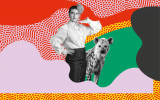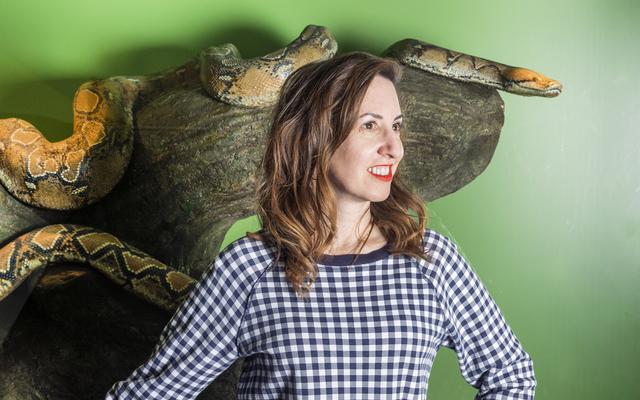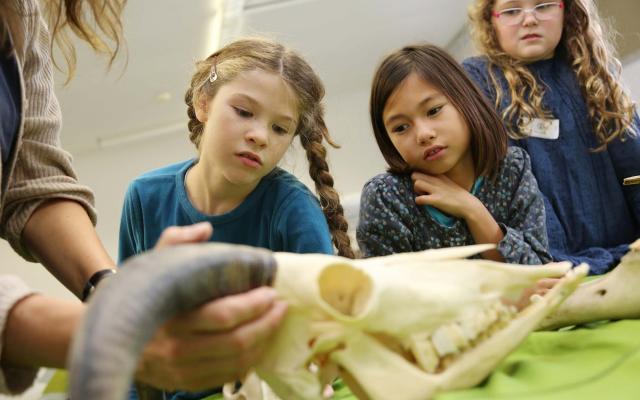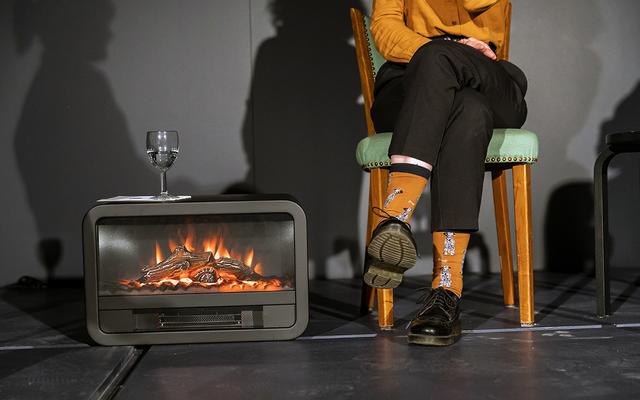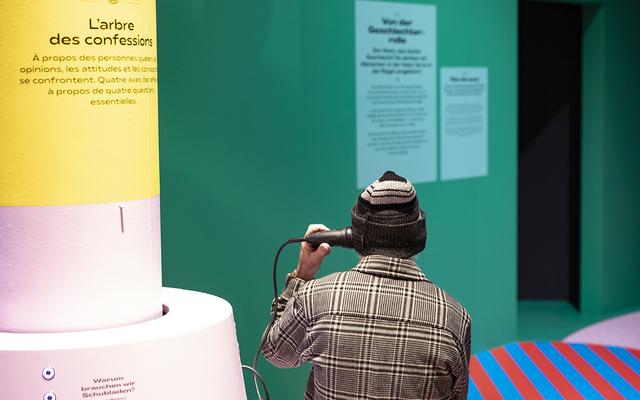Even though we use the term «queer» for humans, there is an extraordinary amount of queerness in the animal world. And even human gender is not as clear-cut as we often assume: Female and male are not fixed categories, but rather two poles between which there is a spectrum. With the growing awareness of diversity in nature, social diversity is also gaining attention. We are in the midst of a social change, this activates creative forces and resistances at the same time.
The exhibition sends visitors on a journey of discovery into the «queer realm», a world that shows the colourful abundance in nature and society that can be found in the topic of gender and sexuality. An expedition in which the visitors also explore their own identity.
All visitors come to the exhibition with their own rucksack of prior knowledge and opinions - some move in the queer scene, others do not know exactly what «queer» even means. The exhibition tries to do justice to this gap by seeing itself as an offer: an offer to fill one's own backpack with new finds of knowledge and insights.
The exhibition is conceived as an abstracted landscape in which visitors are to move freely and make their discoveries. The landscape is divided into four zones, which are marked with different ground colours. In an intro film, the visitors are briefed for the upcoming adventure. They receive an expedition booklet as equipment. The booklet serves as orientation and documents the visitors' own personal expedition. At several stations and with a questionnaire, the visitors explore their own identity.
Verführungen
Queere Menschen entern die Ausstellung und geben eine ganz persönliche Führung. Jeweils am ersten Mittwoch und Donnerstag im Monat. Die Verführungen können auch privat gebucht werden.
Für Schulklassen und Lehrpersonen
- Anmeldung für den Schulklassenbesuch
-
Sie wollen mit Ihrer Klasse die Ausstellung besuchen?
Sämtliche Informationen zum Besuch und die verfügbaren Termine und Anmeldung finden Sie hier .
- Workshops für Schulklassen
-
Der interaktive Workshop «Queerfeldein – eine Reise in die Vielfalt unserer Natur» zeigt die Vielfalt des Lebens auf und das Wissen darüber, dass kein Geschlecht «natürlicher» oder «echter» als ein anderes ist.
Für SuS ab 12 Jahren, max. 24 Personen.
Der Workshop kann auch von Erwachsenen-Gruppen (Betriebe etc.) gebucht werden.
- Didaktisches Material
-
Ist hier aufgeschaltet.
- Einführung für Lehrpersonen ins didaktische Material
-
Der Kurs behandelt die praktischen Möglichkeiten um mit den didaktischen Materialien zur Ausstellung «Queer- Vielfalt ist unsere Natur» einen spannenden Unterricht im Museum zu gestalten.
- Kontakt
-
Wenden Sie sich an unser Team Bildung und Vermittlung für weitere Informationen.
Book private tours (with queer guides), workshops (for groups, businesses, etc) and events at the exhibition - please contact the Head of Gastro and Events or book the event directly on our website.
Great honour: The exhibition «Queer - Diversity is our Nature» receives the Prix Expo 2021 of the Swiss Academy of Sciences. Read more...
An excerpt from the SCNAT media release of 23.11.2021 reads:
«Skilfully, the exhibition makers:in span the arc between nature and culture society, drawing visitors into a celebration of gender diversity with much to discover. The Prix Expo jury was impressed by the way the exhibition comprehensively, informatively, diversely and sensitively sets a sensitive and socially extremely relevant topic in a strong and courageous scenography, and this with the inclusion of very different people and their experiences. The exhibition is courageously staged because it comprehensively argues and lets people experience that there is no 'norm' for a human sexual orientation and that a modern society should perceive, tolerate and celebrate human diversity of gender identities as enrichment. ...»
In September 2022, the exhibition also received a Swiss Diversity Award.
In the short video, a few of the makers involved have their say.
In the short video, a few of the people involved have their say. NMBE Rodriguez
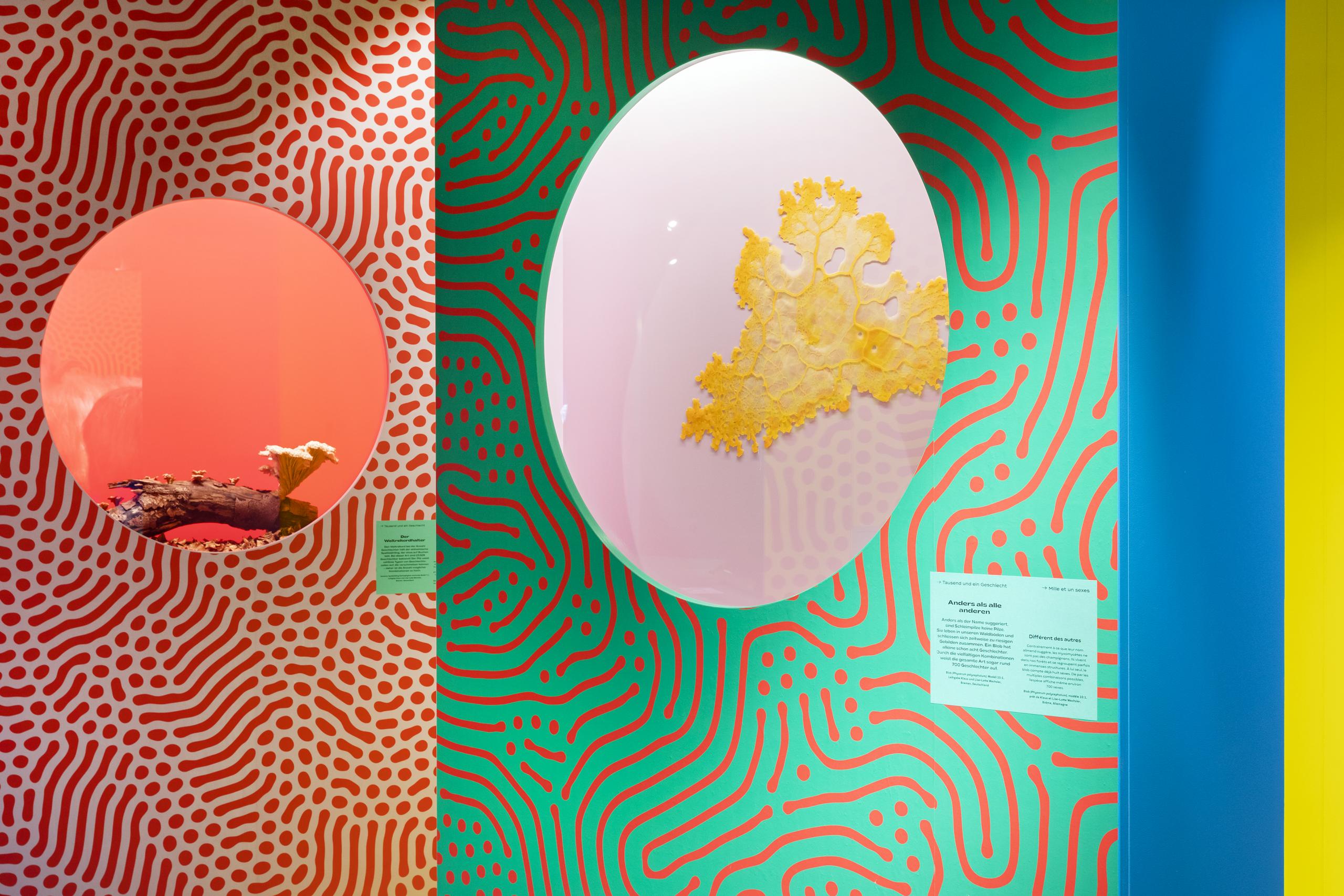
What is there to see?
Diversity - Nothing is normal in nature
The first zone is about «queerness» in nature: it takes a detailed look at gender diversity in the animal world (sex change, hermaphrodites, virgin birth, one or even thousands of sexes). It shows, for example, the clownfish, which can change its sex at the touch of a button, the Caucasian field lizard, which has no males, or the common cleftleaf lizard, which has 23,328 sexes. What functions do such phenomena have? What evolutionary purpose do they fulfil - or do they even have to? It is also discussed here that homosexual behaviour is widespread in the animal world (observed in over 1500 species) and that there are no generally fixed gender roles in nature. For example, the red-fronted leaf chicken keeps a male harem, the male helmet cassowary is a single father and the females of the spotted hyena are more aggressive than the males and have higher testosterone levels.
Body Worlds - Our bodies, the beautiful jumble of sexual characteristics
The English language is more precise when it comes to gender: it distinguishes between gender (social sex) and sex (biological sex). In German, gender is a rather comprehensive term, because we also mean gender identity, that is, the inner knowledge of what sex we are. Accordingly, it becomes more complicated when the biological sex does not correspond to this identity.
The «Body Worlds» zone breaks down the concept of gender into its component parts and takes a comprehensive look at biological sex - which is more complex than most people probably assume. Scientifically speaking, as individuals we move along a spectrum that fans out between typically male and typically female. The biological sex of humans is determined by at least seven aspects. In addition, this section of the exhibition explains how gender comes into being and why there are genders at all.
In the vast majority of cases, gender diversity is not to be seen as a problem but as an enrichment - this is what the photographic installation «Wesensreise» by two artists (Daniel Bolliger and Timon Imveldt) stands for, which is in dialogue with the scientific facts.
Forces - Social change gives rise to energy, creative and destructive.
Humans are cultural beings by nature. In this part we look at social aspects of queerness and the cultural impact of our gender diversity. Old norms and values are in flux, creating resistance, but also constructive energy, for example in language, in culture - and in individual lives. These forces are illuminated by a station with seven biographies, a language quiz and an identity quiz. The station «Creative Engine» gives an impression of the sheer abundance of queer culture and "Destructive Forces" shows the reality that queer people still suffer from discrimination and violence. On the «Tree of Confessions», four bright minds (such as the psychoanalyst Peter Schneider) answer four relevant questions - for example, what is actually natural or how queer the Bible is.
Future - How we will think about gender and sexuality tomorrow
In the gallery, visitors can not only take a look at the exhibition from above, they can also take a look into the future. What will our society look like in twenty years? We take up two focal points here (sport and men giving birth) and at the end of the exhibition we let the youth have their say, who will shape the society of tomorrow.
Culture and nature
The exhibition is certainly not a classic exhibition for a natural history museum, it builds a bridge between nature and culture. It not only deals with the animal world and humans as biological beings, it also touches on the cultural and social aspects that arise from it.
My personal expedition
The visitors should also think about themselves. For this reason, they are given an expedition booklet with which they are encouraged to question their views and their own identity - and also to leave their views in the exhibition.
Guided tour for visitors
The tour is not linear. There is no predefined path that the visitors have to follow. Just like a real expedition, the visitors find their own way.
Age recommendation
We recommend the exhibition for children aged 12 and over. However, it is not forbidden to visit the exhibition with younger children.
Live animals
There are live animals in the exhibition. All animals are kept in an animal-friendly manner. The seahorse aquarium was designed and co-supervised by the Bern Zoo.
Impressum
- Gesamtleitung
-
Christoph Beer
- Projektleitung
-
Katharina Weistroffer
- Konzept
-
Peter Auchli,
Timon Imveldt,
Simon Jäggi,
Christian Kropf,
Thea Sonderegger,
Katharina Weistroffer - Wissenschaftliche Kuration
-
Christian Kropf
- Ausstellungskuration
-
Simon Jäggi
- Steuergruppe
-
Nino Fund,
Henry Hohmann,
Bernhard Pulver,
Michael Schorer,
Detlef Vögeli,
Flavia Wasserfallen
Gestaltung
- Szenografie
-
Peter Auchli,
Thea Sonderegger - Visuelle Gestaltung und Illustrationen
-
Thea Sonderegger
- Grafik
-
Jonas Oehrli
- Präparation
-
Sirpa Kurz,
Constantin Latt,
Angélique Oberholzer,
Sarah Rainer-Pranter,
Martin Troxler
Inhalt und Text
- Texte
-
Simon Jäggi,
Christian Kropf - Interviews
-
Simon Jäggi
- Lektorat und Korrektorat
-
Henry Hohmann
- Übersetzungen
-
Supertext,
Henri-Daniel Wibaut,
Eva Reynolds - Mitarbeit «Identitätsquiz», «Komplimen-Tier»
-
Piet Baumgartner,
Lukas Frei,
Anna Rosenwasser - Transkription
-
Lomotion AG,
Effie Kammer - Künstler «Wesensreise»
-
Daniel Bolliger,
Timon Imveldt - Mitarbeit «Kreativer Motor»
-
Timon Imveldt
Medien
- Multimediakonzept und Interaction Design
-
Peter Auchli
- Filme und Schnitt
-
Lomotion AG
- Audio
-
Peter von Siebenthal,
Projektstudio GmbH - Sprecher*innen
-
Fabienne Biever,
Noah Egli,
Barbara Heynen,
Marie Omlin,
Milva Stark,
Diego Valsecchi - Interviews
-
Audrey Aegerter,
Paula Angst,
Kaspar Blumenstein,
Marianne Dahinden,
Henrik von Dewitz,
Dominik Dummermuth,
Jael l'Epplattenier,
Henry Hohmann,
Tanja Krones,
Daniel Kuhn,
Soukey Mboup,
Deborah Mühlebach,
Marie-Lou Nussbaum,
Monika Risse,
Peter Schneider,
Achim Steffen,
Pöili Vaucher,
Zéphyr Vaucher,
Mathias Wirth,
Florian Zbinden - Schauspiel und Mitarbeit Intro
-
Jovana Hitz
- Model Plakat
-
Jovana Hitz
Öffentlichkeitsarbeit
- Bildung und Vermittlung
-
Katharina Lienhard,
Andrea Röhrig,
Martin Ryser - Mitarbeit Bildung und Vermittlung
-
Félix Duméril,
Basil Huwyler,
Diego Valsecchi - Marketing und Kommunikation
-
Sonja Delz,
Anna-Pierina Godenzi,
Simon Jäggi - Pressefotografie und Dokumentation
-
Nelly Rodriguez
- Rahmenprogramm
-
Sonja Delz,
Anna-Pierina Godenzi,
Simon Jäggi,
Katharina Lienhard
Technik und Bauten
- Möbelbau und Objektmontage
-
Markus Holzer,
Stephan Schlup - Bauten
-
Gratschi Jud
- Elektro-und Technikarbeiten
-
Christian Bähler,
Mark Bähler,
Denise Mast - Bodenlegearbeiten
-
Daniel Stern
- Lichtplanung
-
Mati AG
- Animatronic «Red Queen», «Identitätsquiz»
-
Renato Grob
- Grafikproduktion
-
Lettra Design
- Maler und Tapezierarbeiten
-
Burkhard & Co,
Thomas Schmutz
Dank an Hannes Baur, Philipp Brunner, Jürg Hadorn, Roman Heggli, Stefan Hertwig, Anette Kuhn, Eike Neubert, Lukas Rüber, Manuel Schweizer, Valentina de Vos, Klaus und Lise-Lotte Wechsler, Mirjam Werlen, Fredy und Gaby Zbinden
Naturhistorisches Museum Wien, Naturhistorisches Museum Basel, Senckenberg Forschungsinstitut und Naturmuseum Frankfurt am Main, Stapferhaus Lenzburg, Tierpark Bern, Queerbooks
